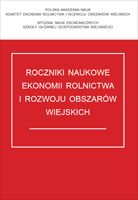Main Article Content
Article Details
Argyle M. 1999: Causes and correlates of happiness. [In:] D. Kahnemean, E. Diener & N. Schwarz (eds.) Wellbeing: the foundations of hedonic psychology. New York, Russell Sage Foundation, pp. 353-373.
Bowling A., Windsor J0. 2001: Towards the good life: a population survey of dimensions of quality of life. Journal of Happiness Studies, 2, pp. 55-81. (Crossref)
CBS (Dutch Central Bureau of Statistics). 1999: Six million people with a long-lasting disorder (Index No. 9, The Hague).
CBS (Dutch Central Bureau of Statistics). 2001: Regional differences in health. Poorer health in four big cities and in South-Limburg (Index No. 9, The Hague).
Cornelisse-Vermaat J.R. 2005: Household production, health and happiness A comparison of the native Dutch and non-western immigrants in the Netherlands. Wageningen, PhD dissertation.
Cornelisse J., Antonides G., Ophem J.A.C. van Maassen, van den Brink H. 2006: Body mass index, perceived health and happiness: their determinants and structural relationships. Social indicators Research, 79, 1, 143-158. (Crossref)
De Hoog K., van Ophem J. 2006: Families and changing life cycles. In: G.Meijer, W.J.M. Heijman, J.A.C. van Ophem and B.H.J. Verstegen (eds.) Heterodox views on Economics and the Economy of the Global Society. Wageningen, Wageningen Academic Publishers, pp 143-154. (Crossref)
Diener E. 1984: Subjective well-being. Psychological Bulletin 95, pp. 542–575. (Crossref)
Diener E., Diener M., Diener C. 1995: Factors predicting the subjective well-being of nations. Journal of Personality and Social Psychology 69, pp. 851-864. (Crossref)
Easterlin R.A. 2001: Income and happiness: towards a unified theory. The Economic Journal 111, pp. 465-484. (Crossref)
Easterlin R.A. 2001a: Life cycle welfare: trends and differences. Journal of Happiness Studies 2, pp. 1-12.
European Commission 2006: Mental Well-being. Special Eurobarometer 248/Wave 64.4-TNS Opinion and Social.
Fontaine K.R., Redden D.T., Wang C., Westfall A.O., Allison D.B. 2003: Years of life lost due to obesity. Journal of American Medical Association 2 (289), pp. 187–193. (Crossref)
Frey B.S., Stutzer A. 2002: What can economists learn from happiness research? Journal of Economic Literature 40, pp. 402–435. (Crossref)
Frey B.S., Stutzer A. 2005: Happiness research: state and prospects. Review of Social Economy, LXIII, 2, 177-207. (Crossref)
Gerdtham U.G., Johannesson M., Lundberg L., Isacson D. 1999: The demand for health: results from new measures of health capital. European Journal of Political Economy 15, pp. 501-521. (Crossref)
Groot W., Maassen van den Brink H. 2002: Age and education differences in marriages and their effects on life satisfaction. Journal of Happiness Studies, 3, 153-165. (Crossref)
Kahneman D. 1994: New challenges to the rationality assumption. Journal of Institutional and Theoretical Economics 150, pp. 18-36.
Kahneman D., Wakker P.P., Sarin R. 1997: Back to Bentham? Explorations of experienced utility. Quarterly Journal of Economics 112, pp. 37-405. (Crossref)
Kapteyn A. 1977: A theory of preference formation. PhD, Leyden University.
Layard R. 2005: Happiness. Lessons from a new science. London, Penguin: Allen Lane.
McGrinnis J.M., Foege W.H. 1993: Actual causes of deaths in the United States. Journal of the American Medical Association, 270(18), pp.2207-2222. (Crossref)
Offer A. 2006: The challenge of affluence: self-control and well-being in the United States and Britain since 1950. Oxford, Oxford UP.
Oswald A.J. 1997: Happiness and economic performance. The Economic Journal 107, 1815-1831. (Crossref)
Oswald J., Powdthave N. 2007: Obesity, unhappiness and The Challenge of affluence: theory and evidence. The Economic Journal, 117 (June), F441-459. (Crossref)
Peters A., Barendregt J.J., Willekens F., Mackenbach J.P., Al Mamun A., Bonneux L. 2003: Obesity in adulthood and its consequences for life expectancy: a life table analysis. Annals of Internal Medicine, 138, 1, 24-32 (Crossref)
Philipson, T. 2001: The world-wide growth of obesity: an economic research agenda. Health Economics, 10. pp 1-7. (Crossref)
Plug E. 1997: Leyden welfare and beyond. Amsterdam. Tinbergen Institute Research Series.
Ross C.E., C.E. Bird 1994: Sex stratification and health lifestyle: consequences for men’s and women’s perceived health. Journal of Health and Social behaviour, 35, pp.161-178. (Crossref)
Schultz T.P. 1994: Overview, theory and measurement. Investment in schooling and health of women and men. Quantities and returns. The Journal of human development 28.4. 694-733. (Crossref)
Te Kloeze J.W., de Hoog K., van Bergen M., Duivenvoorden M. 1996: Tussen vrijheid en gebondenheid. Het postmoderne gezin ontdekt. Leuven/Apeldoorn, Garant.
Van Praag B., Ferrer-i-Carbonell A. 2004: Happiness quantified. A satisfaction calculus. New York, Oxford University Press. (Crossref)
Van Praag B.M.S., Kapteyn A. 1973: Further evidence on the individual welfare function of income: an empirical investigation in the Netherlands. European Economic Review, 4, pp.33-62. (Crossref)
Veenhoven R. 1984: Conditions of happiness. Dordrecht, Reidel. (Crossref)
Veenhoven R. 1997: Advances in understanding happiness. Revue Quebecoise de Psychologie, 18.pp. 29-74.
Veenhoven R. 2004: The greatest happiness principle. Happiness as an aim in public policy. In: A.Linely and S. Joseph(eds.) Positive psychology in practice. Hoboken, NJ. Wiley & Sons.
Veenhoven R. 2005: Apparent quality of life in nations: how long and happy people live. Social Indicators Research, 71, pp 61-86. (Crossref)
Vernon M. 1998: Rethinking households. An atomistic perspective on European living arrangements. London and New York: Routledge. (Crossref)
Wannamethee S.G., Shaper A.G. 1991: Self-assessment of health status and mortality in middle-aged British men. International Journal of Epidemiology, 20(1), pp.239-245. (Crossref)
World Health Organization (WHO) 2000: Obesity: preventing and managing the global epidemic. WHO Technical Report Series 894, WHO, Geneva.
Young M. The symmetrical Family. Harmondsworh: Allan Lane The Penguin Press.
Downloads
- Piotr Sulewski, Powierzchnia użytków rolnych a efektywność gospodarstw rodzinnych , Roczniki Naukowe Ekonomii Rolnictwa i Rozwoju Obszarów Wiejskich: Tom 94 Nr 2 (2008)
Możesz również Rozpocznij zaawansowane wyszukiwanie podobieństw dla tego artykułu.




